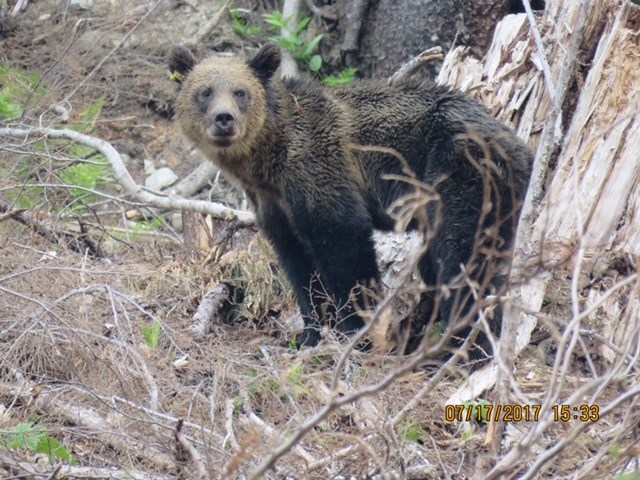
One of three grizzly bears relocated from Sicamous in July 2017.
Image Credit: Conservation Officer Service
July 24, 2017 - 4:53 PM
SICAMOUS - The Conservation Officer Service hopes a group of three female grizzly bears will thrive in their new home after being translocated from Sicamous.
Conservation officer Ken Owens says the bears were getting into attractants, such as corn and fruit, near residences over the past month and were jeopardizing public safety.
The presence of these grizzlies at the southern tip of the Columbia-Shuswap grizzly bear population represented an important link with the Monashee grizzly bear population, Owens says, and the likelihood of them being female posed a significant conservation opportunity.
The bears’ behaviour and level of habituation was assessed and they were deemed to be good candidates for translocation.
“Conservation Officers worked hard over four days to capture all three bears. (All were) successfully captured, tranquilized, ear tagged and translocated to the far end of their home range within the Monashee Mountains,” Owens says.
Upon capture, it was confirmed that all three bears were female and indeed represent an important component of the Columbia Shuswap grizzly bear population, Owens says.
“We hope that they will thrive in their new location in the hopes of one day producing new offspring,” he says. “The Sicamous community is relieved to have these bears safely removed and officers have received many positive comments from community members.”
However, Owens says that while the story is a success for conservation on one hand, on the other it represents a failure to control and restrict access to attractants.
“Translocation is not without risk and will cost far more than taking proactive steps to prevent the creation of problem bears and will not stop the problem in the medium to long-term,” Owens says.
Bears that are translocated are exposed to large amounts of stress and generally suffer high mortality rates once transferred.
“This measure was taken as an interim measure to allow residents adequate time to properly secure and prevent access to attractants. It is like a 'get-out-of-jail-free' card for the community of Sicamous,” Owens says.
He’s reminding the public that bears that become highly food-conditioned and habituated to humans are often killed because of concerns for human safety.
It is an offence under the B.C. Wildlife Act to attract, or leave an attractant accessible to dangerous wildlife (bears, coyotes, wolves and cougars).
Owens is encouraging people to look into bear electric fencing, a safe, inexpensive and effective way to keep both wildlife, pets, poultry and/or livestock safe.
To report wildlife in conflict, contact the Conservation Officer Service reporting line at 1-877-952-7277.
To learn how to keep wildlife wild and our communities safe, click here.
— This story was updated at 8:30 a.m. July 25, 2017 to change the main photo.
To contact a reporter for this story, email Charlotte Helston or call 250-309-5230 or email the editor. You can also submit photos, videos or news tips to the newsroom and be entered to win a monthly prize draw.
We welcome your comments and opinions on our stories but play nice. We won't censor or delete comments unless they contain off-topic statements or links, unnecessary vulgarity, false facts, spam or obviously fake profiles. If you have any concerns about what you see in comments, email the editor in the link above.
News from © iNFOnews, 2017